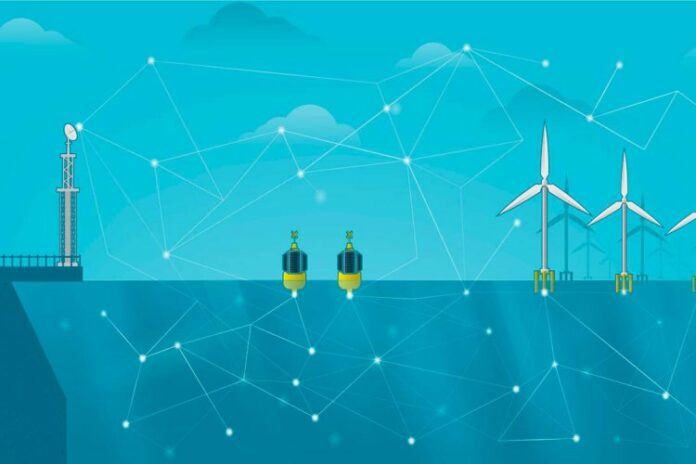The £2.8m project will accelerate the development of a new generation of digital technologies essential for the huge expansion of offshore wind generation required to meet climate targets. It is being driven by a consortium led by the Offshore Renewable Energy (ORE) Catapult and bringing together the expertise of Microsoft, Vilicom, JET Connectivity, XceCo, Associated British Ports (ABP), Acceleran and Satellite Applications Catapult.
The offshore wind sector is growing rapidly, increasing the need for Operations & Maintenance (O&M), which can be both expensive and hazardous. On average, O&M accounts for 25% of the total lifetime cost of an offshore wind farm, and as the sector expands, there is a strong push to reduce this cost by using robotics and autonomous solutions to support necessary inspections, maintenance and repair.
The 5G Testbed will allow technology providers to test and demonstrate their equipment in real world conditions, with access to reliable, high-speed communications. It aims to kickstart a digital revolution in offshore wind O&M in the region and attract users from the global offshore wind sector.
Ben George, head of Smart Operations and Maintenance (O&M) at ORE Catapult, said:
“This 5G Testbed is a hugely exciting development for O&M in offshore renewable energy, as it establishes the core communications infrastructure for the biggest offshore wind ‘living lab’ in the world. The Testbed will demonstrate the benefits of new remote digital solutions that require high bandwidth, low latency wireless communications – aimed at making O&M safer, greener and more effective.
“It will provide a real-world development, demonstration and test zone for robotics and autonomous systems (RAS), remote sensors, wearable technology, cyber security, zero emission vessels, smart ports, and aquaculture that will drive the digital future of O&M. This gives UK innovators and technology developers the upper hand as they bring new products and services to market, including for export into an offshore wind sector that is booming around the world.
“We are delighted to be working with our group of expert partners as we seek to transform the Humber into a new ‘silicon estuary’.”
To create the Testbed, two 5G technology development and demonstration zones over the existing fibre network will be built – one at Grimsby Port and the other within the Lynn and Inner Dowsing wind farm. Fifteen 5G radio transmitters will be placed across five sites including wind turbines and a radio mast, and two 5G solar powered buoys will provide an extended 5G network beyond the range of the wind farm. JET Connectivity is providing the 5G solar powered buoys for the project.
Credited for being the world’s largest operations and maintenance (O&M) offshore hub, the Port of Grimsby is an established centre of excellence for these activities for Round 1 and 2 wind farms in the North Sea. The port offers a number of sites suitable for the development of the operations and maintenance (O&M) industry, as well as other offshore wind-associated activities.
Simon Bird, ABP Humber Regional Director, commented:
“We are very proud that our Port of Grimsby has been chosen as the primary site for the 5G network and look forward to working with partners on this project to make it a success. At ABP, we’re committed to supporting innovation in the renewable energy sector, alongside decarbonising our own operations, as reflected in our net zero sustainability strategy, Ready for Tomorrow, which was launched last month.”
The offshore wind sector is growing rapidly, increasing the need for O&M, which is currently expensive and hazardous. On average, O&M accounts for 25% of the total lifetime cost of an offshore wind farm, and as the sector expands, there is a strong push to reduce this cost by using robotics and autonomous solutions to support necessary inspections, maintenance and repair.
However, many new digital solutions rely on high-fidelity wireless data communications that 5G provides, and while 5G is being installed in new wind farms, these are not available for wider development and testing. This project will create the 5G infrastructure that provides an accessible and operationally integrated Testbed for new technologies that are essential to the roll out of offshore wind globally.
The project will be funded with £1m from the Innovate UK Cyber Physical Infrastructure (CPI) fund, an expected £1m from the Greater Lincolnshire Local Enterprise Partnership (LEP), and industry match funding.
Halina Davies, Partnerships and Programmes Executive Manager for the Greater Lincolnshire LEP, added: “We are delighted to be working with ORE Catapult to enable progression of this exciting and innovative scheme and have provisionally agreed support via our Clean Growth Accelerator Fund Programme.
“The 5G testbed will create a unique asset, expertise and capability that will attract inward investment from the UK and around the world, enabling innovation in leading edge technologies to be proven in an operational setting, ultimately creating 200 jobs, assisting over 120 businesses and creating 20 new enterprises.”
In the UK, offshore wind capacity is predicted to grow from 13GW to 50GW within the next decade, and globally, the rapid investment in offshore wind will create huge opportunities for the UK wind industry. The 5G Testbed project will be based at ORE Catapult’s Operations and Maintenance Centre of Excellence in Grimsby, the UK’s largest O&M port.



